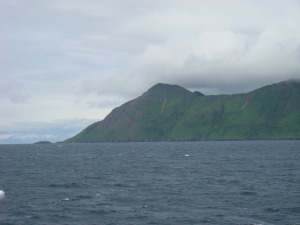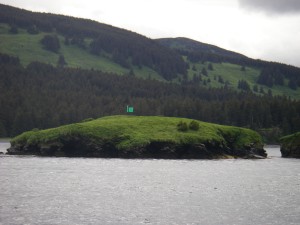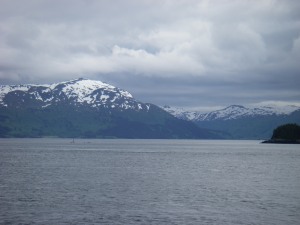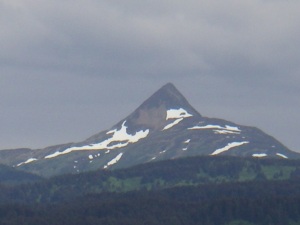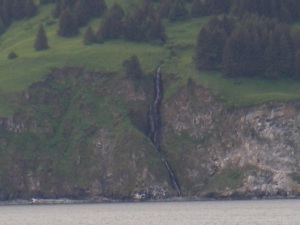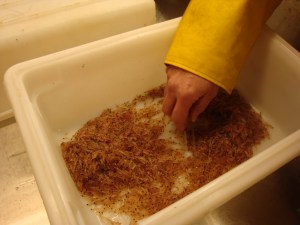NOAA Teacher at Sea
Gail Tang
Aboard NOAA Ship Oscar Elton Sette
August 4, 2023 – September 1, 2023
Mission: Hawaiian Islands Cetacean and Ecosystem Assessment Survey (HICEAS)
Geographic Area of Cruise: Hawaiian archipelago
Date: Tuesday August 8, 2023
Weather Data from the Bridge
Temperature: 27.06° C
Latitude: 29°53’0” N
Longitude; 174°24’0”W
Science and Technology Log with Career Highlights
Previously, I wrote about the day-time operations focused on surveying whales, dolphins, and birds. Through the 25-powered binoculars (big eyes), the large mammals in the distance look microscopic. Now, the sun has set and I take us underwater to learn about the tiny world of ichthyoplankton, magnified to reveal intricate details of their exquisite structures.
Weather permitting, Nich Sucher (Survey Technician) works with the deck crew to deploy the CTD, which measures conductivity, temperature, and depth. This information is used to help scientists understand the physical, chemical, and biological changes of the ocean to help inform them of environmental changes. For example, Nich explained that data from CTDs are used to better understand why tuna were migrating away from Hawaii and towards California. The data can help answer whether the tuna are moving north for access to more oxygen in the water or for cooler temperatures. On our project, we deploy the CTD down to 1000m because that is where some of our deep diving cetacean species feed. Also, the temperature & pressure affects how sound travels through the water. This information can be used to calculate the speed of sound at different depths.
Nich wanted to work for NOAA since he was in middle school! In high school he fell in love with fish. Initially he went to college in Iowa for soccer and then transferred to Carthage College, in Kenosha, Wisconsin to study environmental science, conservation and ecology. Nich did an independent study with his aquatic ecology professor on a coral reef project in Roatan, Hondurus. His senior thesis investigated the feasibility of releasing captive-bred axolotl (an adorable salamander that’s critically endangered and possibly extinct in nature) into the wild. After college, he had a job at an aquarium, and while he temped at US Fish and Wildlife studying chub and salmon, NOAA reached out about his job application. He started in January 2022 on the NOAA Ship Oscar Elton Sette!

Since the CTD is deployed to 1000m, a common extracurricular activity is to attach styrofoam objects to the instrument because they shrink as a result of the pressure! On a previous leg, Commanding Officer Fionna Matheson shrunk a styrofoam head, which can be seen in the picture of Nich above. A few of us shrunk decorated styrofoam cups.




The whole process of the CTD deployment and retrieval takes about an hour to an hour and a half. The Isaacs-Kidd Midwater Trawl (IKMT) net tow usually follows. Jessie Perelman and Dre Schmidt are the plankton researchers on board this leg of HICEAS. Most nights, we do 2-3 tows of the net. (They are affectionately called a “tow-yo” because the net gets towed in and out several times.) They use an inclinometer, a.k.a. angled angle, to measure the angle of the line (see picture below) and then confer with a chart to determine the length of the line needed to reach the desired depth. The chart is a good way to avoid on-the-spot trigonometric calculations. But it’s a good exercise to ask yourself anyway: if you know the desired depth and the angle, how would you calculate the length of the line needed?
After the tows, we bring the larvae into the wet lab and the fun begins. The goal is to sort out the fish larvae from the other larvae. Truthfully, I am not very good at sorting the fish and I just like to look at the organisms under the microscope. The most awe-inspiring creatures I saw under the scope were the shelled pteropods (sea butterflies) and a juvenile sea star that, according to Dre, may have recently morphed from the larval stage. With the naked eye, they look like marks made with a sharp pencil, but under the scope, the enormity of their existence is profoundly moving. While I could not capture these beauties in a photograph, I was able to capture other creatures.


Personal/Food Log with Career Highlights
As I fall into a daily routine, I periodically need small bits of irregularity for stimulation. This week, I was privileged enough to work with Chef Chris. Chef Chris is originally from north Philadelphia. In the absence of cable during childhood, he watched cooking shows like Yan Can Cook, Frugal Gourmet, and Julia Child on PBS. He started off cooking on NOAA Ship Rainier and now is the Chief Steward on NOAA Ship Oscar Elton Sette. We collaborated to make some pork dumplings and vegetable spring rolls for everyone. I cook at home often, but not for so many people, so Chris was essential in helping me scale up the dishes. We bonded over not measuring out ingredients so here is approximately the two recipes we used.
Pork Dumpling Filling
- 5 lbs of ground pork (when my mom makes these, we use a mix of lean ground pork and fatty ground pork)
- Mirin (I use Shaioxing wine, but mirin is a good substitute!)
- Soy sauce (we used Kikkoman; I like to use Pearl River Bridge Light Soy)
- Green onions
- Sugar


Egg Roll Filling
- Green cabbage
- Red Cabbage
- Carrots
- Mushrooms
- Soy sauce
- Hoisin


Several of us worked together to help fold the dumplings and egg rolls. I delighted in the number of different hands that contributed to feeding our community. Chef Chris expertly cooked everything and it was all gobbled up!



At night, I assist Jessie Perelman and Dre Schimdt with their plankton research. They were the first to come by to help fold dumplings. Jessie did her undergraduate work in biological science at University of Southern California (USC) with a plan to go to veterinary school. She worked in a marine science lab at USC, and then studied abroad in Australia to take more marine biology classes not available at USC. After she graduated, she got a job as research assistant at Wood’s Hole Oceanographic Institution, where she solidified her passion for research. She applied for graduate school and ended up at the University of Hawaii studying biological oceanography. Her dissertation focused on oceanographic influences on mesopelagic communities across eastern Pacific Ocean using insights from active acoustics, nets, and other sampling techniques. An interesting interdisciplinary part of her background includes learning about international policy on issues like deep sea mining. The international meetings with delegates were very informative for her. She’s also worked on science communication writing, such as science blogging. In Fall 2022, Jessie started as a Marine Ecosystem Research Analyst at NOAA!
Dre Schmidt received her bachelors in biology at Florida State University. She took Calculus, Mathematical Modeling for Biology, Analysis and Statistical Design, and Physics to supplement her biology degree. She volunteered at a research lab on campus and after college, took a couple of years off to work in marine science education for 5th grade to college level students. She went for her master’s degree in Kiel, Germany to study physiological effects of low-level warming on coral and their larvae. She has been at NOAA for 2 years, first as a research associate and now as an essential fish habitat coordinator. What she loves about her job is the variety of responsibilities. She keeps busy by sorting plankton, doing genetics lab work, analyzing data in R, writing up results, and going to sea! Engaging in these different tasks help to activate different parts of the brain, which I can totally relate to! Her advice to students is to know your worth and ask for what you deserve. Her favorite fish larva is the very ugly Centrobranchus andreae simply because her name is found within the name of the organism. I can’t blame her because my favorite flower is the Gaillardia for the same reason.
Matt Benes (Able-bodied Seaman and Deck Boss) took a break in his duties to fold some dumplings with us. Though Matt declined to be interviewed, I can tell you we share a deep appreciation for food as a mechanism for cultural, historical, and political understanding.
Jamie Delgado (Medical Officer) joined in on the egg roll wrapping. Jamie received her bachelor’s in science and nursing at Rutgers University. She joined the Public Health Service (PHS), and worked at the Indian Health Service (IHS) in northern Arizona. Later, she worked at the National Institutes of Health (NIH) as a research nurse specialist. Jamie earned her Doctor of Nursing at University of Maryland before coming to NOAA as ship medical officer. Jamie has so much good financial advice about scholarships and loan repayments programs. Check out these links to learn more:
- https://www.ihs.gov/careeropps/loanrepayment/
- https://bhw.hrsa.gov/funding/apply-loan-repayment/nurse-corps
- https://usphs.gov/about-us#where-we-work
She also shared that you can retire in a total of 20 years with uniformed services, you get a pension, healthcare benefits, a housing allowance, a food allowance, 30 days paid leave, and unlimited sick leave. Jamie has been in service for 10 years, and with NOAA for 1 year and 5 months.
Jamie also helped me out during our in-port during Leg 1. Snorkeling had dislodged some ear wax and clogged my ear for a couple of days making daily life really uncomfortable. Jason Dlugos’s (3rd Assistant Engineer) “ear beer” helped, but I was still off balance. Jamie had to endure the task of flushing my ear out over the course of two days. Eventually, I did have to go to urgent care to get the rest out. Now I’m 100%!
Last but never least, Octavio De Mena, a.k.a OC, (General Vessel Assistant in the Deck Department) came by to roll some egg rolls. He is originally from the Republic of Panama and loves classic rock music. While we have no intersection in our movie tastes, we share some similarities in the food we ate growing up due to the large Chinese population in Panama. According to the Harvard Review of Latin America, the first Chinese immigrants arrived in Panama in 1854 to build the Trans-Isthmian Railroad. The inhumane treatment and disregard for the workers’ welfare is reminiscent of the situation a decade later with the Transcontinental Railway in the United States. This convergence of cultures led to haw flakes and dried plums in both our childhoods!
OC was an aircraft mechanic in the military reserves, and a security contractor in Latin America. He decided to come back to the U.S. to fulfill his dream job as a professional mariner. On his journey in pursuing his dream, he volunteered for the civil air patrol, and served as an auxiliary for search and rescue flying small Cessnas. He saw a NOAA ship at this job which prompted a search for a position within NOAA. He has been on the NOAA Ship Oscar Elton Sette since February 2023. On the ship, OC and I are regulars in the forward mess. Sometimes having opposite tastes works out in your f(l)avor, as I get to eat OC’s tomatoes and watermelon jolly ranchers.
Did you know?
You can track us! Visit this site to see where we currently are: https://www.windy.com/station/ship-wtee?26.549,-172.551,5








































